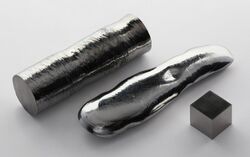Rhenium, 75 Rhenium Pronunciation (REE -nee-əm Appearance silvery-grayish Standard atomic weight A r, std (Re) [1] Rhenium in the periodic table
Atomic number (Z ) 75 Group group 7 Period period 6 Block d-block Element category d-block Electron configuration [Xe ] 4f14 5d5 6s2 Electrons per shell 2, 8, 18, 32, 13, 2 Physical properties Phase at STP solid Melting point 3459 K (3186 °C, 5767 °F) Boiling point 5903 K (5630 °C, 10,170 °F) Density (near r.t. ) 21.02 g/cm3 when liquid (at m.p. ) 18.9 g/cm3 Heat of fusion 60.43 kJ/mol Heat of vaporization 704 kJ/mol Molar heat capacity 25.48 J/(mol·K) Vapor pressure
P (Pa)
1
10
100
1 k
10 k
100 k
at T (K)
3303
3614
4009
4500
5127
5954
Atomic properties Oxidation states −3, −1, 0, +1, +2, +3, +4 acidic oxide) Electronegativity Pauling scale: 1.9 Ionization energies 1st: 760 kJ/mol 2nd: 1260 kJ/mol 3rd: 2510 kJ/mol (more ) Atomic radius empirical: 137 pm Covalent radius 151±7 pm Spectral lines of rheniumOther properties Natural occurrence primordial Crystal structure hexagonal close-packed (hcp) Speed of sound thin rod 4700 m/s (at 20 °C) Thermal expansion 6.2 µm/(m·K) Thermal conductivity 48.0 W/(m·K) Electrical resistivity 193 nΩ·m (at 20 °C) Magnetic ordering paramagnetic [2] Magnetic susceptibility +67.6·10−6 cm3 /mol (293 K)[3] Young's modulus 463 GPa Shear modulus 178 GPa Bulk modulus 370 GPa Poisson ratio 0.30 Mohs hardness 7.0 Vickers hardness 1350–7850 MPa Brinell hardness 1320–2500 MPa CAS Number 7440-15-5 History Naming after the river Rhine (German: Rhein ) Discovery Masataka Ogawa (1908) First isolation Masataka Ogawa (1919) Named by Walter Noddack , Ida Noddack , Otto Berg (1925) Main isotopes of rhenium
Category: Rhenium view · talk · edit references
Re
data m.p. cat
in
calc from C
diff
report
ref
C
3186
—
—
K
3459
3459
0
F
5767
5767
0
max precision
0
WD
input
C: 3186, K: 3459, F: 5767
comment
Re
data b.p. cat
in
calc from C
diff
report
ref
C
5630
—
—
K
5903
5900
3
delta
F
10170
10170
0
max precision
0
WD
input
C: 5630, K: 5903, F: 10,170
comment
References These references will appear in the article, but this list appears only on this page.
↑ Meija, Juris; Coplen, Tyler B.; Berglund, Michael; Brand, Willi A.; De Bièvre, Paul; Gröning, Manfred; Holden, Norman E.; Irrgeher, Johanna et al . (2016). "Atomic weights of the elements 2013 (IUPAC Technical Report)". Pure and Applied Chemistry 88 (3): 265–91. doi :10.1515/pac-2015-0305 . ↑ Lide, D. R., ed (2005). "Magnetic susceptibility of the elements and inorganic compounds" . CRC Handbook of Chemistry and Physics (86th ed.). Boca Raton (FL): CRC Press. ISBN 0-8493-0486-5 . https://web.archive.org/web/20110303222309/http://www-d0.fnal.gov/hardware/cal/lvps_info/engineering/elementmagn.pdf . ↑ Weast, Robert (1984). CRC, Handbook of Chemistry and Physics . Boca Raton, Florida: Chemical Rubber Company Publishing. pp. E110. ISBN 0-8493-0464-4 . Template:Documentation


